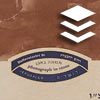A sign belonging to the "Photograph in Stone" series. In this series, which is located mainly in the center of Jerusalem, historical buildings, prominent figures in the city’s history and more are commemorated.
The house on which the sign is located was photographed that day
 Click for a larger image Translation of the text on the sign
Click for a larger image Translation of the text on the sign:
Symbol of the "Photograph in Stone" project - Ohel Moshe 1882 - JERUSALEM
Isaac and Rachel Beja The family originates from the city of Beja in Portugal. The family was deported in 1496 and came to Thessaloniki, Greece and Izmir, Turkey.
In 1880, the family immigrated to Old Jerusalem and preserved the rooted Spanish tradition and was included in the ST community (Jerusalem-based Spanish community).
Yitzhak was born to his father Yosef and mother Rivka in 1924 at Misgav Ladach Hospital in the Old City of Jerusalem. Following the 1939 riots, his family was forced to abandon their home and business in the Old City and live outside the walls, in the Ohel Moshe neighborhood.
Out of a sense of mission he chose to serve from 1942-1945 as a flight inspector in the Royal Air Force of the British Army in Ismailia.
Upon his release he assisted the Irgun underground in the expulsion of the British occupying power, at the time of the establishment of the state, he enlisted in the IDF and was one of the founders of the temporary airport in Sheikh Bader (Sucker Garden).
In light of his social skills and the languages he acquired during his life and out of a mission to get to know the Ohel Moshe neighborhood with its Spanish roots, Yitzhak volunteered to guide tourist groups on behalf of the Jewish Agency as well as groups of soldiers.
His guidance was always spiced with humor, Zionism and love of the people and the country.
During his years of marriage, Yitzchak studied at the Yeshiva of the Kabbalists, Nahal Shalom, headed by the late Rabbi Mordechai Sharabi and was one of his most prominent students.
At the end of his life, Yitzhak earned the nickname "Minister of the Zohar" due to his knowledge and control of the Book of Zohar.
Rachel, a member of the Cohen family, was born in 1930 in Baghdad, Iraq, and immigrated to Eretz Israel with her family in 1936. As a child, she lived in the "Nahalat Zion" neighborhood.
Throughout her life, she worked for the love of man and for giving kindness to the needy, while at the same time devoting her soul to raising a family.
In 1952, Isaac and Rachel married. The couple had seven children, Bracha, Moshe, Hannah, Yosef, Michal, Yael, and Yoav.
[Ponche Ponche A popular love song in Ladino]
Puncha, puncha Puncha, puncha
the rose smells
That love hurts a lot
You were not born for me
I lend alexate from me
Be prepared for that hour
that I kiss your mouth
That hour has passed
pain was left to the heart
High mountains and seas, deep,
Take me onde’l my dear,
Take me onde’l my love.
The one who gives me consolation
The installation was donated by the Baja family, in memory of the parents
[Photo: Yitzhak and Rachel Beja on their wedding day]

 Click for a larger image
Click for a larger image  Click for all signs belonging to Photograph in stone - Jerusalem
Click for all signs belonging to Photograph in stone - Jerusalem
 9 Meter |
9 Meter |  10 Meter |
10 Meter |  12 Meter |
12 Meter |  14 Meter |
14 Meter |  16 Meter
16 Meter